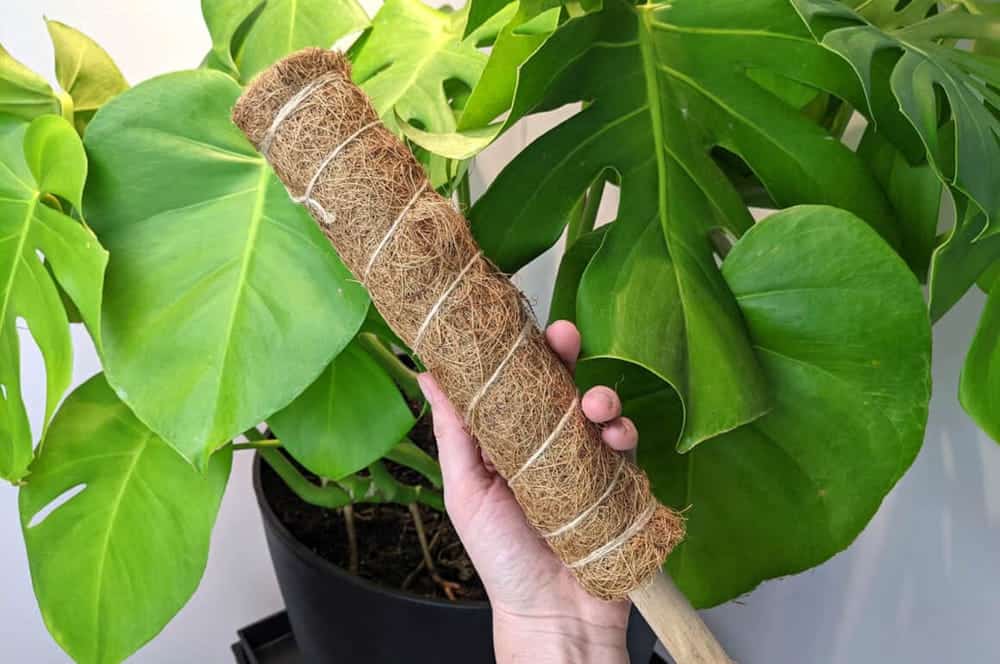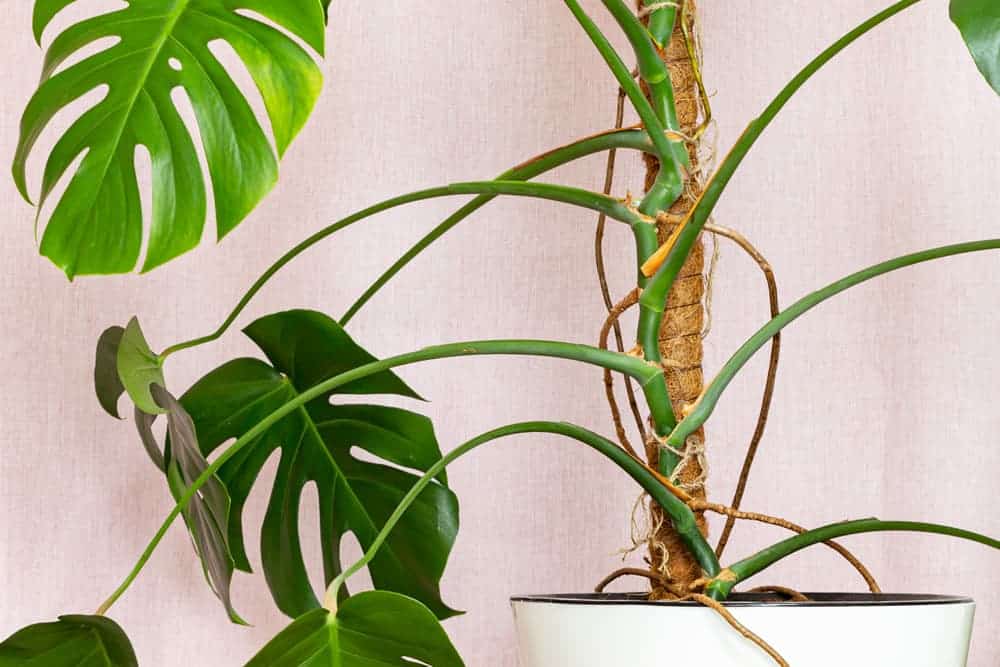Monstera deliciosa is one of those plants that many people love to grow indoors because of the eye-catching beauty of its leaves. The leaves of this plant are large and green. They have interlacing slits that make them more special than other ornamental plants.
Monstera deliciosa has a relatively fast growth rate and can create a mini-forest in your house. Unlike some other plants, Monstera deliciosa tends to grow wider and take up more of the surrounding area.
So if you have a tight space then Monstera deliciosa might not be the best choice. However, you can train them to climb on stakes or trusses to save space. Is Training Monstera to climb possible? How to train Monstera to climb poles? Let’s learn about how to do it in detail in the article below.
Training Monstera To Climb – Why Do You Need To Do This?
Monstera deliciosa is a trainable plant to climb wooden stakes or trusses if you provide ideal living conditions and the right support measures. The best way to help plants climb is to use moss poles, coir poles, or nets. Monstera deliciosa will cling to supports to climb vertically and stimulate growth in height.
This method also trains plants to follow their natural climbing tendencies and can lead to a healthier plant with larger leaves. For some small plants, you can hang them on the wall or hanging. However, Monstera deliciosa is a large plant, so you should use moss poles, and wooden stakes to help them climb.
Monstera deliciosa usually grows upright on only a few stems when young. However, it begins to grow laterally as it grows older and heavier. As a result, they will encroach on the surrounding space and or cover other smaller pots.

To train plants to climb up poles and grow upright, you should prune the lower leaves or stems to limit the surrounding space. It will help plants focus their energy only on the stems and leaves above and vertically. Depending on the area and size of the plants you want, you can use one or two moss sticks to train them to climb in different directions. In addition, you can also apply the natural principles of plants such as facing the light. You can use lights to attract them to grow up to absorb light.
Monstera climb naturally, but it takes time for their aerial roots to attach to supporting structures like moss poles or netting. This process can take a long time because the root system on the stem takes time to adapt and firmly attach to the support. Once the root system is in place, plants will focus their energy on growing stems and leaves in an upward direction.
When Should I Train Monstera Deliciosa To Climb?
As you know, Monstera deliciosa will be small in size when young and large when mature. In particular, they tend to grow wider around instead of vertically. So, when you find that the branches show signs of leaning or drooping around, you should use a moss post or a net to fix it.
In particular, when mature, the weight of the stem and leaves is also heavier, making the plant unable to keep its original shape. So this is also the time when you need to use support to fix it. If you ignore this moment for too long, the stems will droop and stiffen making the pot very messy.
What’s more, if you grow Monstera deliciosa in areas that lack sunlight or have limited light, the plants will also tend to tilt in search of light. Using moss stakes or a fixture will help keep your potted plants in good shape.
In addition, when you discover roots growing on the trunk and tending to cling to other trunks, you should use moss stakes or train them to climb. The aerial roots are a sign that the plant has matured and the trunk branches are also developing most vigorously.
You should use moss piles or coir piles because they have organic ingredients to hold moisture well. From there, the aerial root system can easily attach and grow as strong as in the soil environment. When planting moss stakes, you should plant slowly and gently because the root system can be easily broken and damaged.
How Can I Change Pot With Moss Or Coir Piles?
The best time to put moss or coir stakes in the pot is when we are repotting. It will be easier to stick the stake in the ground without damaging the plant’s root system. Because when plants have grown and matured, their root systems will stick to the soil. So, you have to break the roots to put the stake.
The new repotting process can be difficult when your plants are large and heavy. Therefore, you should grow plants in plastic pots. Because plastic is light in weight and easy to bend or change shape. You may find it easier to get the plants out of the pot when growing them in clay or porcelain pots.
You need to prepare a new pot that is the right size for the plants. Choose fresh, porous potting soil to make planting moss piles easier. You just need to stick the moss stake in the ground and fix it so that it stands upright. Then, you replant the stem branches into the pot and secure them to the moss stakes for them to cling to.
It’s best to change the pot Monstera deliciosa in early spring before the growing season begins. At this point, plants are still growing slowly after going through dormancy, and nutrients in the soil have been depleted. In particular, when you repot at this time, your plants can maximize their growing season and start growing on moss piles.

Steps To Repotting And Depositing Moss
First, you need to determine where to place the moss stake in the pot. Usually, one will place the stand on the opposite side of where the tree is becoming too heavy or unbalanced. You need to prepare good-quality moss piles and high-quality potting soil.
You take the plant out of the old pot slowly and gently. Make sure to limit the broken and damaged root system. You need to check the root system and remove any rotten, diseased, or poorly grown branches. If your plants are still in the balance, simply place them in a new pot in the middle. However, if your plant is growing to one side or one side is much fuller than the other, you can rotate the root ball so that the plant is more vertically oriented.
Once you’ve determined where to place the plants in your new pot, you can backfill it with soil to cover the root system. Plants should not be left outside for too long because they can become dehydrated or stressed. Once you’re done, stick the moss stake in the pot deep enough for the soil to hold the stake in place. Fill in the soil around the moss column until it is in place. Water thoroughly and then add soil if necessary.
You can either secure the largest and heaviest stems to a moss pole to keep the plants growing vertically. Or stimulate the roots from the stem to attach to the moss stake. If you have large stems that grow horizontally, you should tie them to a stake to prevent further spreading.
You need to take the time to train the large trunks because they are not flexible enough to bend immediately. Instead, you will bend them gradually over a few rounds to bring the large trunk to the position you want. Tie a string from the moss stake to the large stem and adjust the distance gradually to draw them closer to the moss stake.
In particular, you can encourage aerial roots to attach to the moss stakes and pull the stems upright. To do this, you need to pay close attention to the growth of the aerial root system. When they start to appear, speed up their growth and secure them to the moss pile when they are long.
When you use a lanyard to secure the stem or roots of a plant, you need to be clever to get the right tension. If you make it too tight, the plant will be damaged but if it is too loose, the process is useless. All in all, Monstera deliciosa is a hardy plant that can recover from some impact. So you do not need to worry too much about their injury and damage during climbing training.
How To Care After Fixing Monstera Deliciosa To Moss Stakes
After using the wire to fix the tree trunk to the moss pile, you should pay attention to observing them for a few days (Especially the areas of direct contact to avoid open wounds). If you tie it too tightly, open wounds will appear, from which bacteria and pests can easily penetrate the trunk. Therefore, you need to carefully observe and customize the tension of the string to be suitable every day.
To promote the growth of plants, you need to use fertilizers with the right amount. Monstera will grow and proliferate rapidly during the spring or summer months. However, this depends on the conditions you provide them with.
If the new tree is staked this season, it will begin to take root in the air to the stake by the end of summer. To check if the aerial roots are not attached to the moss stake, you can loosen the ties. If they stay in place when untying, you’ve successfully trained your Monstera to attach to the moss stake. If the aerial root system has not yet been attached to the stake, you do not need to worry, give them time and wait patiently. In particular, you can completely use the rope to fix the roots for a long time.
Conclusion
Monstera deliciosa is a plant that is large in size and weight when mature. It tends to grow in width and encroach on surrounding spaces. So you can use moss stakes or nets to train them to climb.
To do this, you should plant moss stakes when repotting to avoid damaging the root system. For items that are large and drooping to the surrounding ground, you can use string to secure them to the moss stake and vary the string tension in batches. Large bodies will not be able to bend quickly so you need to be patient to train.
After planting the new stake, the aerial roots can attach to the pot and form a strong relationship with the new stems. You can also secure the roots to a moss stake and wait for them to entwine. Don’t forget to remove the ropes or fix them to the roots for a long time.
You need to adjust the tension of the rope appropriately and avoid tying it too tight to create open wounds. From there, pests and insects will easily attack plants through open wounds. You need to clean the places where the lanyard comes into direct contact with the trunk to limit the growth of fungus.